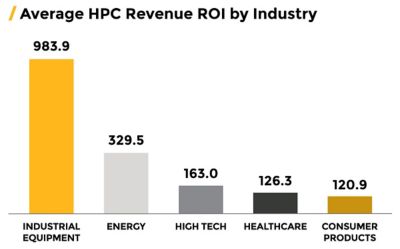-
United States -
United Kingdom -
India -
France -
Deutschland -
Italia -
日本 -
대한민국 -
中国 -
台灣
-
Ansys는 학생들에게 시뮬레이션 엔지니어링 소프트웨어를 무료로 제공함으로써 오늘날의 학생들의 성장을 지속적으로 지원하고 있습니다.
-
Ansys는 학생들에게 시뮬레이션 엔지니어링 소프트웨어를 무료로 제공함으로써 오늘날의 학생들의 성장을 지속적으로 지원하고 있습니다.
-
Ansys는 학생들에게 시뮬레이션 엔지니어링 소프트웨어를 무료로 제공함으로써 오늘날의 학생들의 성장을 지속적으로 지원하고 있습니다.
ANSYS BLOG
May 19, 2023
Survey Reports Substantial Returns on Investment in HPC for Engineering Simulation Applications
At Ansys, we’ve made claims over the years about the value of engineering simulation in terms of time and money saved on projects by companies who use simulation as a major component of their product development process. These claims were always based on numbers or more general statements provided to us by companies using our software. Now, we have engaged Hyperion Research to perform an independent research survey on the subject to obtain a more precise quantitative picture of the benefits of Ansys simulation solutions. The results indicate that combining Ansys solutions with high-performance computing (HPC) lead to substantial returns on investment (ROI) across industries.
The survey, based on 71 projects involving Ansys simulation solutions, shows that on average $151.90 in revenue were generated per dollar of HPC invested. In addition, $34.90 of profit (or cost savings) were generated per dollar of HPC invested, according to the survey. Of particular interest is the contrast in profits generated for projects that used HPC primarily on-premises versus HPC used primarily in the cloud.
| Ansys HPC Project Usage | Revenue per Dollar of HPC Invested | Profit (or Cost Savings) per Dollar of HPC Invested |
| Primarily on-premises (>90%) | $224.70 | $29.70 |
| Hybrid on-premises and in the cloud | $45.70 | $26.40 |
| Primarily in the cloud (>90%) | $70.10 | $55.60 |
| Overall HPC ROI | $151.90 | $34.90 |
While the on-premises HPC projects generated a substantially higher revenue ROI of $224.70 per dollar of HPC invested compared to $70.10 for HPC projects run in the cloud, an opposite trend is evident for the profit/cost savings ROI. Namely, the average profit/cost savings ROI for Ansys HPC projects run in the cloud exceeds that of those on premises, $55.60 per dollar of HPC invested compared to $29.70, respectively. Although the survey didn’t investigate the reasons for this difference, running simulations in the cloud allows organizations to quickly scale their computing resources up or down as needed for simulation projects, which can help them avoid the costs associated with over-provisioning or under-provisioning resources.
"Our HPC resources allowed us to run many advanced fluid dynamics simulations on various designs for the inhaler. Ansys Fluent allows us to significantly optimize the design of our inhaler-based drug delivery products in silico while simultaneously reducing our prototype and testing costs."
— Survey response from a scientific computing engineer at a leading pharmaceutical company
This survey also revealed additional insight into project ROIs and the types of projects and industries that benefit the most from HPC.

Average industry revenue ROIs per dollar invested in high-performance computing (HPC).
Innovation Areas and Industries Benefit from HPC
The two most popular innovation areas for HPC among survey respondents were making better products (40% of projects) and creating cost savings (20% of projects), both of which had high revenue and profit/cost savings return on investment ratios. The data shows that innovations aimed at opening new market segments and sustainability have strong revenue and profit/cost savings ROI, but more projects are needed to confirm these trends.
Respondents categorized their organization's industry and the types of returns on investment seen from the project. The combination of these data sets shows each industry's success and project goals. The industrial equipment industry had the highest revenue ROI, with an average of $983.90 per dollar invested into HPC, while the healthcare industry had the highest profit/cost savings ROI, with an average of $116.70 per dollar invested. All industries had revenue and profit/cost savings ROIs greater than one, indicating successful engineering simulation investments into HPC.

Attaining High ROI for HPC
By categorizing projects into basic and applied research, the survey also sheds light on the importance of investing in HPC at the right point in a project's timeline to achieve the highest ROI. For example, applied research had an average revenue ROI ratio of 179.60 and a profit/cost savings ROI of 42.10, while basic research had an average revenue ROI ratio of 32.10 and a profit/cost savings ROI of 3.90. These findings suggest that investing in HPC for optimization purposes and incremental innovations might be more beneficial and yield higher returns than investing in HPC for pioneering discoveries.
“HPC resources allow us to iterate at a much faster pace and perform optimization around our designs. We are able to perform multiple simulations in parallel with different operating conditions and quickly find the most likely optimal configuration.”
— Survey response from a computational fluid dynamics scientist at a leading fusion energy company
Through this survey, we provide tangible evidence that Ansys HPC projects yield substantial returns in terms of revenue, profit, and cost savings. To learn more, watch the webinar "High Return on Investment with Ansys Software on HPC Infrastructure," or download the "Driving Return on Investment with Engineering Simulation Software on HPC Infrastructure" white paper, which includes the survey results.










